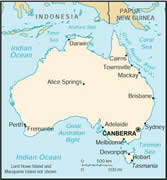National Energy Grid
|
 |
|
Full Size Map National Electricity Transmission Grid of Australia(27 kb) |
GRID SUMMARY
As of January 2000, Australia had an electrical generation capacity of 43 million kilowatts (or gigawatts). Approximately 84% of this capacity was thermal (mostly coal) and 14% of it was from renewables (mostly hydro). In 2000, Australia generated 202.7 billion kilowatthours (BkWh) of electricity and consumed 188.5 BkWh. ABARE expects electricity usage to grow by 2.8% per year over the course of this decade.
Renewable Energy
Australia is relatively well endowed with renewable
energy resources, including solar, biomass and
wind power. Renewable energy is often a viable
alternative to diesel-generated electricity in
remote areas of Australia, such as parts of Tasmania,
Western Australia and the Northern Territory, that
do not have access to the main electricity grids.
The Renewable Remote Power Generation Program,
which began in July 2000, provides financial support
for the conversion of diesel-based generators to
generators dependent upon renewable energy resources
and technologies. The Photovoltaic Rebate Program
was designed specifically to support installation
of grid-connected or stand-alone photovoltaic systems.
Participants can receive rebates up to $8,250 for
a 1,500-watt photovoltaic system.
In early 2000, researchers, industry experts and government officials met in Canberra to discuss the potential for biomass as a future energy source. Utilization of biomass as an energy resource could be very important for a country, where, according to Minister of Agriculture, Fisheries,& Forestry, Warren Truss, agriculture contributes up to 22% of total greenhouse gas emissions. Utilization of biomass not only could provide a use for many agricultural wastes, but also could encourage tree plantings which would help provide relief for areas experiencing erosion.
Wind energy also is a feasible renewable energy alternative. The Australian Wind Energy Association has pledged to increase the country's wind power generating capacity from 72 MW in 2001, to 5,000 MW by 2010. In July 2001, Pacific Hydro Ltd. opened Australia's largest wind farm in Codrington, Victoria. The $US 16.7-million project has a generating capacity of 18 MW. Renewable energy currently provides about 5% of Australia's electricity generation, with further increases depending partially on pending legislation that would require electricity suppliers to source an additional 2% of their electricity from renewable energy by 2010.